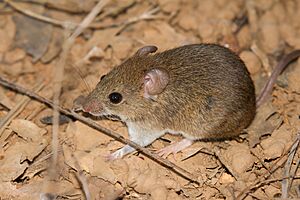Hairy-tailed bolo mouse facts for kids
Quick facts for kids Hairy-tailed bolo mouse |
|
|---|---|
 |
|
| Conservation status | |
| Scientific classification | |
| Genus: |
Necromys
|
| Species: |
lasiurus
|
The hairy-tailed bolo mouse (Necromys lasiurus) is a small rodent that lives in South America. It is also sometimes called the hairy-tailed akodont. You can find this mouse in countries like Argentina, Bolivia, Brazil, and Paraguay. It belongs to the Cricetidae family, which includes many types of mice and hamsters.
Contents
About the Hairy-tailed Bolo Mouse
This mouse is quite small. Its body, from head to tail base, measures about 11.8 to 13.8 centimeters (4.6 to 5.4 inches) long. Its tail adds another 6.6 to 9.6 centimeters (2.6 to 3.8 inches) to its total length.
What it Looks Like
The hairy-tailed bolo mouse has small, round ears with only a few hairs on them. Its fur color can change, but usually, its back is olive-grey to dark brown. The sides of its body are lighter, often with a hint of yellow-brown. Its belly is white or light grey. The line where the dark fur meets the light fur is not very clear.
Its tail is dark on top and light underneath. It has short, thick fur. The mouse's feet are brown on top, and it has small tufts of white hair between its toes. Its nails are strong, helping it move around.
Where it Lives and What it Likes
The hairy-tailed bolo mouse is native to the southern parts of South America. It lives across eastern and central Brazil, reaching as far west as Rondônia. You can also find it in eastern Paraguay and northeastern Argentina.
Its Home Environment
This mouse prefers to live in open grasslands. It also likes the edges of farm fields and areas where forests have grown back after being cut down. These places provide good cover and food for the mouse.
Life and Habits of the Hairy-tailed Bolo Mouse
The hairy-tailed bolo mouse is mostly active during the day. However, it can also be busy during twilight hours and at night, especially when the weather is dry.
What it Eats
The mouse's diet changes depending on the time of year. It mainly eats seeds and green plants. Sometimes, it also enjoys small invertebrates, which are tiny creatures without backbones, like insects.
Reproduction and Life Cycle
The breeding season for these mice usually happens in the spring and summer months. When a mother mouse has babies, she typically has about five young in each litter.
Health and the Hairy-tailed Bolo Mouse
This mouse can carry certain hantaviruses. One example is the Araraquara strain found in Brazil. These viruses can sometimes make people sick. The mouse is also a host for a type of intestinal worm called Moniliformis necromysi.


